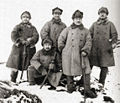Battle of Attu
| Battle of Attu | |||||||
|---|---|---|---|---|---|---|---|
| Part of the Pacific Theater of World War II | |||||||
 American troops on Attu during the battle. | |||||||
| |||||||
| Belligerents | |||||||
|
|
| ||||||
| Commanders and leaders | |||||||
|
John L. DeWitt Thomas C. Kinkaid Albert E. Brown Eugene M. Landrum Archibald V. Arnold | Yasuyo Yamasaki † | ||||||
| Strength | |||||||
| 15,000 | 2,900 | ||||||
| Casualties and losses | |||||||
|
549 killed, 1,148 wounded, 2,100 evacuated for disease or climate-related injury |
2,850+ killed, 29 captured | ||||||
The Battle of Attu took place May 11, 1943 – May 30, 1943 on Attu Island off of Alaska as part of the Aleutian Islands Campaign during the Pacific War of World War II. Fought entirely between the United States and the Empire of Japan, it was the only land battle of the Pacific war fought on territory that was part of the incorporated territory of the United States. It is also the only battle in which Japanese and American forces fought on snow and ice.
Battle

In the battle, a force of primarily United States Army soldiers landed on Attu with the goal of retaking the island from Japanese forces who had occupied the island since October 1942. The American forces on the island were led in turn by Albert E. Brown and Eugene M. Landrum. The Japanese forces on Attu were led by Yasuyo Yamasaki.
The Japanese troops on the island put up a more effective defense than the Americans anticipated. Also, the Arctic weather conditions caused many cases of frostbite and other exposure-related injuries among the American troops, who were not accustomed to the climate conditions. With some difficulty, the Americans were able to push Yamasaki's men into a pocket near the coast of the island.
Yamasaki and his remaining troops launched a surprise counter attack, executing a Banzai charge that broke through the American front line. Japanese troops engaged in hand-to-hand combat with shocked American rear-echelon troops until most of the Japanese were killed.
This charge then effectively ended the battle for the island. Only 29 of the 2,900 Japanese defenders survived the battle to be taken prisoner.
Attu was the last ground combat in the campaign. The Japanese successfully evacuated their garrison on nearby Kiska on July 28, 1943 ending the Japanese presence in the Aleutian Islands.
Gallery
|
See also
References
- Cloe, John Haile (1990). The Aleutian Warriors: A History of the 11th Air Force and Fleet Air Wing 4. Missoula, Montana: Pictorial Histories Publishing Co. and Anchorage Chapter – Air Force Association. ISBN 0929521358. OCLC 25370916.
{{cite book}}: Cite has empty unknown parameter:|coauthors=(help) - Dickrell, Jeff (2001). Center of the Storm: The Bombing of Dutch Harbor and the Experience of Patrol Wing Four in the Aleutians, Summer 1942. Missoula, Montana: Pictorial Histories Publishing Co., Inc. ISBN 1575100924. OCLC 50242148.
{{cite book}}: Cite has empty unknown parameter:|coauthors=(help) - Feinberg, Leonard (1992). Where the Williwaw Blows: The Aleutian Islands-World War II. Pilgrims' Process. ISBN 097106098-3. OCLC 57146667.
{{cite book}}: Cite has empty unknown parameter:|coauthors=(help) - Garfield, Brian (1995) [1969]. The Thousand-Mile War: World War II in Alaska and the Aleutians. Fairbanks: University of Alaska Press. ISBN 0912006838. OCLC 33358488.
{{cite book}}: Cite has empty unknown parameter:|coauthors=(help) - Goldstein, Donald M. (1992). The Williwaw War: The Arkansas National Guard in the Aleutians in World War. Fayettville: University of Arkansas Press. ISBN 1557282420. OCLC 24912734.
{{cite book}}: Unknown parameter|coauthors=ignored (|author=suggested) (help) - Hays, Otis (2004). Alaska's Hidden Wars: Secret Campaigns on the North Pacific Rim. University of Alaska Press. ISBN 188996364X.
{{cite book}}: Cite has empty unknown parameter:|coauthors=(help) - Lorelli, John A. (1984). The Battle of the Komandorski Islands. Annapolis: United States Naval Institute. ISBN 0870210939. OCLC 10824413.
{{cite book}}: Cite has empty unknown parameter:|coauthors=(help) - Morison, Samuel Eliot (2001) [1951]. Aleutians, Gilberts and Marshalls, June 1942-April 1944, vol. 7 of History of United States Naval Operations in World War II. Champaign: University of Illinois Press. ISBN 0316583057. OCLC 7288530.
{{cite book}}: Cite has empty unknown parameter:|coauthors=(help) - Parshall, Jonathan (2005). Shattered Sword: The Untold Story of the Battle of Midway. Dulles, Virginia: Potomac Books. OCLC 60373935. ISBN 1574889230.
{{cite book}}: Unknown parameter|coauthors=ignored (|author=suggested) (help) - Perras, Galen Roger (2003). Stepping Stones to Nowhere, The Aleutian Islands, Alaska, and American Military Strategy, 1867 - 1945. Vancouver: University of British Columbia Press. ISBN 1591148367. OCLC 53015264.
{{cite book}}: Cite has empty unknown parameter:|coauthors=(help) - Urwin, Gregory J. W. (2000). The Capture of Attu: A World War II Battle as Told by the Men Who Fought There. Bison Books. ISBN 080329557X.
{{cite book}}: Cite has empty unknown parameter:|coauthors=(help) - Wetterhahn, Ralph (2004). The Last Flight of Bomber 31: Harrowing Tales of American and Japanese Pilots Who Fought World War II's Arctic Air Campaign. Da Capo Press. ISBN 0786713607.
{{cite book}}: Cite has empty unknown parameter:|coauthors=(help)
External links
- Logistics Problems on Attu by Robert E. Burks.
- Aleutian Islands Chronology
- Aleutian Islands War
- Aleutian Islands The U.S. Army Campaigns of World War II
- Red White Black & Blue - feature documentary about The Battle of Attu in the Aleutians during World War II
- PBS Independent Lens presentation of Red White Black & Blue - The Making Of and other resources
- Soldiers of the 184th Infantry, 7th ID in the Pacific, 1943-1945
- World War II Campaign Brochure for Aleutian Islands, U.S. Army Center of Military History.
- US Army Infantry Combat pamphlet- Part Two: Attu
- Oral history interview with Robert Jeanfaivre, navy veteran who took part in the Battle of Attu from the Veterans History Project at Central Connecticut State University


















